Pros
Cons
Physical Tour
The Casio EX-V7’s front looks similar to that of the Sony T-series or Nikon S-series cameras because of the sliding metal lens cover. On the V7, this cover has a big Exilim logo on it and slides to the left to reveal the lens and flash. There is a slight dip in the camera’s body where the door tracks back and forth, but the front is otherwise flat. Below this central dip are a string of words: "7.2 Mega Pixels Digital Camera EX-V7, Stereo." To the right of these words and directly below the internal lens is a relatively large, square window. This is the AF assist lamp, and it is strangely placed. In the bottom right corner of the front is the Casio logo. When the cover is slid back, the built-in flash takes up real estate directly above the lens.
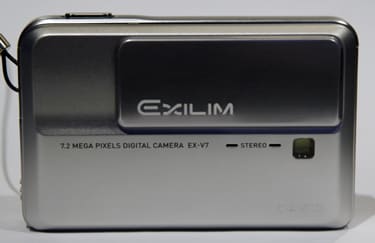
Back
The back of the Casio V7 has a 2.5-inch LCD screen framed in black on the left side, with the Exilim logo showing in white against the black on the bottom. To the right of the screen is over an inch of space covered in controls and buttons. There is a mode dial in the top right corner, which doesn’t protrude much from any angle. In the bottom right corner is a multi-selector that is about the same size as the dial. The size works fine for the mode dial, but the multi-selector would be more functional if it was a little larger. The selector has a central Set button and a ring surrounding it. The ring is almost flush with the camera body, and requires a firm push to get to it navigate anywhere. The top of the selector is labeled "Disp." and changes the display info on the LCD screen. The bottom of the control has trash and flash icons. The left and right sides don’t have icons, but can be set to store quick access to features through the setup menu. Between the multi-selector and the LCD screen are two small and rectangular buttons: playback on the top and menu on the bottom. Directly above these, between the mode dial and the monitor, is the vertically aligned zoom control. It consists of a sliding component that moves up to zoom in or down to zoom out. Most zoom controls are horizontally aligned and honestly aren’t as comfortable as the one on the Casio V7.
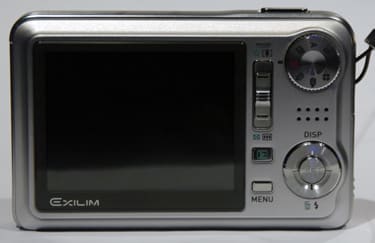
Left Side
The Exilim V7’s left side is featureless. It has only visual appeal with the shiny chrome element running down the center of the two plastic panels.
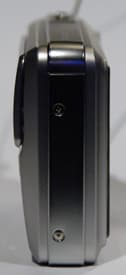
**Right Side
**Near the bottom of the right side is a door that blends in fairly well with the rest of the camera body. This hides the battery and memory card in the tiny compartment.

**Top
**Also quite free from distractions is the top, which has only the shutter release button on the right and a "7x Optical Zoom" label on the left.
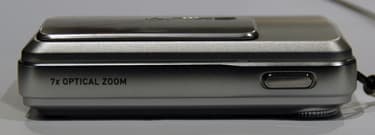
**Bottom
**The center of the bottom has a USB connection to the included dock. It is from there that users can access ports and cables to hook up to printers, computers, televisions, and other devices. The tripod socket is located on the far right edge, which could make shooting level on a tripod difficult because the weight of the other side will likely pull it crooked.

Components
Viewfinder
The Casio Exilim EX-V7 doesn’t have the space for an optical viewfinder, but uses the live view on the LCD screen. The screen measures 2.5 inches across and has plenty of resolution at 230,000 pixels. The size and resolution of the screen are great, but the refresh rate isn’t anything to envy. Subjects blur easily when the camera is moved – not because the camera can’t focus (although it does have its issues there too), but because the refresh rate on the screen isn’t very fast. The display information on the live view can be changed by pushing the top of the multi-selector (labeled Disp.). The screen can be blank, show basic info, and show the full info with a live histogram. Grid lines can be added too, but only through the setup menu. Overall, the V7’s live view is great – unless you move the camera.
LCD Screen

The Super Bright LCD screen on the V7 is large and endowed with enough resolution for enjoyable viewing. The screen has good contrast, and is helped out by the camera’s ability to brighten even more. In the setup menu, users can choose from 0, +1, +2, Auto 1, and Auto 2 settings. The automatic screen brightening settings don’t provide much info on how they are different, but I was told by Casio reps that the #2 setting is for more drastic changes like walking out of the basement into daylight. I couldn’t test this in the convention center, but the screen is supposed to automatically adjust its brightness according to the environmental lighting.
The screen has a wide viewing angle when held out to the side. It’s a different story when held above or below eye-level though; the image quickly solarizes into a negative. Thus, this Exilim isn’t made for holding up at concerts; it would be better at holding around a corner and sneaking a picture or two.
**Flash **

Located in the top right corner of the front is the skinny built-in flash unit that casts decent light at best. The flash isn’t that powerful; it can reach from 0.3-7.2 ft when the lens is at its widest. When the lens is zoomed in, the flash is only effective in the narrow range from 3.3-4.6 ft. The intensity can be adjusted +/- 2 in full steps within the recording menu, but the flash still doesn’t reach farther than 7.2 ft at its most powerful setting. There is a Rapid Flash mode that uses the flash in a burst of pictures, but the flash intensity is toned down to save power; in this mode, light can only reach 6.9 ft. There is a Soft Flash mode that is easier to access and succeeds in diffusing the harsh lighting enough for a good portrait. Auto, On, Off, and Red-Eye Reduction are the other flash modes available with Soft Flash and found by pushing the bottom portion of the multi-selector. There are no major bright spots in the frame as far as I could tell. The flash’s range makes it hardly usable in many situations though.
Zoom Lens

The internal 7x optical zoom lens is the flagship feature of the Exilim Hi-Zoom EX-V7, making it one of a handful of ultra-zoom / ultra-thin digital cameras. Casio makes a big deal out of the V7 being "the world’s thinnest 7x optical zoom digital camera," but this isn’t such a feat when Kodak has a 10x digital camera that’s thinner (although it uses internal 3x and 5x lenses that have a 10x range, but a gap between the two that shows up as a big jump in the live view). The Casio lens can deliver 10x zoom too, but only with a reduced resolution of 3 megapixels. However, more should be made of the EX-V7's image stabilization system - a key feature the Kodak lacks.
The zoom lens is made of 12 lenses in 9 groups, with 1 aspherical lens. Its range moves from 6.3-44.1mm, or an equivalent 38-266mm in 35mm photography. The Casio V7 moves throughout this range via the zoom control located to the right of the LCD screen. This control looks like a vertical bar, and slides up to zoom in and down to zoom out. This unique control is surprisingly comfortable and very sensitive too. I coaxed 37 different focal lengths out of it, which is very impressive.
The lens’ aperture range isn’t very good. The largest it gets is f/3.4, which it retains throughout the zoom range but still doesn’t get in much light when compared with the standard f/2.8. This could cause quite a few blurry images from slower shutter speeds, so Casio added an Anti-Shake setting in the recording menu. It consists of the following options: Auto, Camera Shake, Image Blur, Demo, and Off. The Camera Shake mode is the V7’s true CCD-shift optical image stabilization system, and it works quite well. It doesn’t completely eliminate blur in every image, but it makes a noticeably positive difference.
Design / Layout
**Model Design / Appearance
**With a look consistent to the trim Exilim series, the Casio V7 keeps a traditional and very compact form. The floor model I looked at is a silver color and is constructed mostly from hard plastic. There are a few metal highlights like the chrome band that runs across the top and sides to cover the seam from the panels, and the sliding lens cover of course. The V7 isn’t quite as sleek and trendy as the Sony T-series or Nikon S-series that are thin and have metal lens covers, but it still looks good.
Size / Portability
This digital camera is thin when compared to other digital cameras that have built-in 7x optical zoom lenses. In fact, Casio advertises its V7 as "the world’s thinnest" with a 7x lens. This may be true, but there are thinner cameras with more zoom available. Still, there are only a small handful of pocket-sized cameras that offer lots of zoom. The Casio Exilim Hi-Zoom EX-V7 measures 2.35 x 3.76 x 1 inch, and is 0.82 inches at its thinnest part. This isn’t as thin as the Exilim Card series cameras, but is still small enough to cram in a pocket. The flat surfaces on the camera make it easier to jam in a pocket too: even the 7x lens doesn’t extend from the body when turned on. The V7 weighs 5.26 oz without the card and batteries, which don’t add much heft. The wrist strap eyelet is set in a niche that makes it even more portable in a pocket because it won’t snag on clothes or anything.
Handling Ability
The flat surfaces on the V7 make it perfect for carrying around in a pocket, but tough if you want to snap more than a few pictures at once. There aren’t many handling features at all. There is no thicker hand grip or thumb grip or anything. The mode dial on the back of the camera does have a little dent in the middle meant to act as a cradle for the thumb, but there isn’t much else to hang onto. The plastic and metal body isn’t boxy; its edges are beveled nicely.
Control Button / Dial Positioning / Size
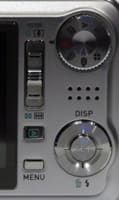
The first thing I noticed about the Casio V7 is that it doesn’t have a power button. Instead, the camera turns on when the lens door is slid to the left and the lens is revealed. The camera can also be turned on if the playback button is held down, but only if that's activated in the setup menu. The lack of a power button was confusing for at least a few people who walked by the Casio booth, picked up the camera, turned it around a few times, threw out a quizzical look, and put it down again.
Another non-traditional control exists on this Exilim: the zoom control. Most compact cameras have horizontal levers on the backs of the cameras or a ring that surrounds the shutter release button and is pushed right and left. Casio departed from tradition and put a vertically aligned zoom control on the back of the camera. This is surprisingly much more comfortable to hold and move than its more traditional counterparts.
All of the other controls are fairly typical of compact models. The shutter release button sits on the top of the camera right where it should be. There is a mode dial on the back where the thumb naturally rests; this dial can be turned from the right side of the camera, but it isn’t very comfortable to do so (hand cramp!). There are two small, rectangular buttons on the back for the playback mode and the menu system. They are a little bit too close, so consumers with large fingers may want to avoid the V7. There is a multi-selector that is the same size as the mode dial – a bit too small for all the navigating it needs to do – but sits almost flush with the camera body. It requires a good firm push to move the multi-selector, making it a bit difficult to navigate. I often accidentally ended up in the wrong menu because of the multi-selector’s mis-navigation.
The buttons are either identified as text (such as the Menu button) or icons (such as the flash portion of the multi-selector). All of the icons are intuitive, and everything is easy to find and access. The exception to that is the right and left sides of the multi-selector. They aren’t labeled at all – but there’s reason for it. They can be set to access several features and so the label can’t be changed with the user’s changing shooting preferences. The following settings can be saved to the left or right sides of the multi-selector: Continuous, EV Shift, WB, ISO, Self-Timer, and Off. Overall, the Casio V7’s control interface is simple and allows users to focus on picture-taking instead of menu-surfing.
Menu
When users do occasionally venture into the menu system via the designated button, they could get a bit overwhelmed. The menus are quite lengthy and require some serious scrolling with the multi-selector (which is not an easy task). Still, the menus are all located in the same place and are well-organized into sub-menus. Across the top of the recording menu are Recording, Quality, and Setup sub-menus. The text is nice and readable, and there aren’t any icons that could confuse beginners.
This next menu is sandwiched in the middle of the sub-menus and titled Quality.
The following is the Setup menu.
Only in the setup menu is it difficult to go back in the menu system after making a change in one setting. It is easier to navigate in the other two menus, except for the finicky multi-selector.
The menu system is organized, and several live views are included to help beginners make better informed decisions. The only drawback to the menus is their sheer length; there is a lot of scrolling involved and many of the menu items in the middle seem to get lost.
**Ease of Use **
The Casio Exilim Hi-Zoom EX-V7 is very easy to use with its 33 Best Shot modes, properly labeled controls, live views in the menu, and intuitive style. There are a few quirks like the moody multi-selector and the lack of handling features, but it takes very little brain power to take a picture with the V7.
Modes
**Auto Mode
**The mode dial’s characters are all black except for a red rectangle: this is the Snapshot mode, which is similar to a Program mode. This mode automates the shutter speed and aperture completely, but still allows access to other manual controls like ISO, flash intensity, and white balance. If users want something a little less complicated, they can turn the dial to the Easy mode designated by a shamrock icon (I always thought a shamrock was an icon for luck, but it almost does take a bit of luck to get a good picture in this mode). When the Menu button is pushed in the Easy mode, the following options appear: Flash, Self-Timer, Image Size, and Exit Menu. The text options are in a huge font on a brightly colored background. When choosing an option, text explanations appear. For instance, the auto flash option read, "Flash fires when required." The Easy mode makes picture-taking very simple, but the resultant pictures aren’t very impressive. Many turned out blurry and under-exposed in the convention center I was shooting in.
Movie Mode
One of the camera’s most advertised features is its movie mode because the camera employs a unique H.264 video encoding method that stores more video in less space. Casio claims that this compression can record about 1.5 times longer than typical MPEG-4 video on the same memory space without losing quality. This is up for debate; I couldn’t compare the video mode side-by-side with a more traditional coding method on the show floor. This is something we will look for upon further review in our testing lab.
The movie mode has several Best Shot modes of its own that can be changed by pushing the Set button: Portrait, Scenery, Night Scene, Fireworks, Backlight, High Sensitivity, Silent, Short Movie, Past Movie, Voice Recording, and Register User Scene. This is in addition to the standard Normal Movie mode. The recording size can be chosen in the Quality menu: UHQ (Ultra High Quality), UHQ Wide, HQ (High Quality), HQ Wide, Normal, and LP. These letters represent the different levels of compression and the 848 x 480, 640 x 480, and 320 x 240-pixel video recording options. The top two resolutions operate at 30 fps, while the smallest size shoots at 15 fps.
The 7x optical zoom lens is available while recording video, which is a bonus as many compact digital cameras still don’t zoom while shooting. I used the High Sensitivity mode in the dim convention center, and the video didn’t look that good. It didn’t look very sharp at all. In the recording menu, users can turn on a recording light.
Movies can be played back in VCR-style with fast-forward, rewind, play, and pause options. Motion prints can be created from the playback menu, and the video can be edited. Stereo audio is recorded with the movies, which is an upgrade from most compact digital cameras that record mono audio. Overall, the movie mode on this pre-production model didn’t perform well in the limited lighting in the convention center but its functional optical zoom and plenty of available options make it a tempting mode to use.
Drive / Burst Mode
The Casio Exilim Hi-Zoom EX-V7 has a burst mode that can be found in the recording menu with these choices: Normal Speed, High Speed, Flash Continuous, and Off. The Normal Speed isn’t very impressive. Casio tags it at a shot every 0.7 seconds, and that seems pretty accurate. Casio’s published specs claim the High Speed mode quickens to 3 fps, but the model at the show only took 2 frames at a time. They were taken in less than a second, but still only two nonetheless. The Flash Continuous moves at that rate too, although the flash’s power doesn’t reach much beyond 6 ½ ft. A self-timer can also be activated through the recording menu too. It can delay the shutter for 10 or 2 seconds, and can activate a triple self-timer that will make snapping a blink-free portrait a lot easier.
Playback Mode
There is a designated playback button on the back of the Casio V7 that enters the world of photos already snapped by the camera. Pictures can be viewed individually, in frames of 9, and in a calendar. They can be viewed and edited with the following playback menu.
There are a lot of interesting options in this playback menu, such as the Dynamic Range and White Balance. These are also available while recording, but are rarely seen in the playback section. Like on other Casio Exilim digital cameras, there are Keystone and Color Correction options. And just like other models, the V7’s two options both activate the keystone function, with the Color Correction option only correcting color after straightening the image.
More typical editing options like trimming, resizing, and rotating are available too. Some of the cooler features are buried in the long playback menu. For instance, users can tag Favorites and save them, but finding that menu item when you want to show them off is a bit more painful than the Favorites position on Kodak’s mode dials.
File information can be hidden or displayed with a touch of the top of the multi-selector. A histogram with red, green, and blue channels can be viewed too. Overall, the playback mode is very thorough. It provides a lot of in-camera editing options for still images and movies, and the high-resolution 2.5-inch LCD screen provides a nice medium for it.
**Custom Image Presets
**Casios are known for their abundance of scene modes. Sure enough, the Exilim V7 has 33 Best Shot modes tailored for every conceivable shooting situation. Here’s the rundown: Portrait, Scenery, Portrait with Scenery, Children, Sports, Candlelight Portrait, Party, Pet, Flower, Natural Green, Autumn Leaves, Soft Flowing Water, Splashing Water, Sundown, Night Scenery, Night Scenery with Portrait, Fireworks, Food, Text, Collection, For eBay, Backlight, High Sensitivity, Monochrome, Retro, Twilight, Layout 1, Layout 2, Auto Framing, ID Photo, Old Photo, Businesscards and Documents, Whiteboard etc, and Register User Scene. Users can scroll through that lengthy list by pushing the Set button and scrolling around with the multi-selector. Casio makes choosing from the many modes a little simpler by adding a guide. When users select a mode and push the zoom control up, they can view a sample photo and a text explanation of the mode. The V7 definitely isn’t short on selection, but is almost overboard. Several of the modes are combinations of each other too (Portrait with Scenery). How long will it be before we see an "auto framing backlight pet action" Best Shot mode?
Control Options
Manual Control Options
The Casio Exilim Hi-Zoom EX-V7 has Manual, Aperture Priority, and Shutter Speed Priority modes directly on the mode dial. The red rectangle icon on the mode dial is called Snapshot mode but could be accurately called a Program mode too. With an Easy mode and 33 Best Shot modes rounding out the selection, there is an exposure mode for everyone on this digital camera. The manual controls aren’t the easiest to access, but that’s the nature of having manual controls on a compact camera that is too small for the comfy dials and buttons of an SLR. The Casio V7 has plenty of other manual controls like white balance, flash intensity, ISO, etc. that will be discussed in the next few sections of this first impressions review.
**Focus
***Auto Focus*
The EX-V7 has a contrast detection auto focus system that is helped out by an auto focus assist lamp. The lamp is strangely placed below the lens on the front of the camera, but its placement doesn’t seem to affect the camera’s performance. AF, Macro, and Infinity focus modes are found in the recording menu, along with Spot, Multi, and Tracking AF Area modes. Normally, the camera can focus from 11.81 inches to infinity. That range shortens to 3.94-15.75 inches in the macro mode. The auto focus system isn’t very impressive. It didn’t add much to the shutter lag, but just plain didn’t do its job much of the time. Pictures didn’t come out exceptionally sharp, and were often blurry. The same story is told in the movie mode too: the auto focus system seemed to have some trouble. We can give the Casio V7 the benefit of the doubt here: I was shooting in the poorly lit convention center, so perhaps it does much better outside where there’s plenty of light. To its credit, the Casio V7’s Tracking auto focus mode is quite impressive and helps considerably. This mode displays a green box over the subject it is tracking, and it tracks them well.
Manual Focus
The manual focus is available in the same Focus Mode menu as the AF, Macro, and Infinity modes. Users can manually focus as close as 3.94 inches. When activated, a yellow box appears in the center of the live view. The screen magnifies this center and users can adjust the focus by pushing on the right and left sides of the multi-selector. On many digital cameras, the resolution on the LCD screen is so bad that it’s hard to see whether the subject is focused or not. This isn’t the case on the V7, which provides a nice clear view.
**ISO
**Previous Casio digital cameras offered paltry ISO ranges from 50-400, so it’s nice to see the V7 extend it a little further. The manual ISO options are available in the Quality menu: Auto, 64, 100, 200, 400, and 800. They are all available at full resolution. An ISO 1600 setting is automatically activated in the High Sensitivity Best Shot mode too. The Anti-Shake mode also uses high ISO sensitivity and fast shutter speeds to reduce blur. Once we get the production model into our lab for testing, we’ll look at how much noise these higher ISO settings produce. Casio has an option that claims to eliminate noise in flat color regions like a blue sky, for instance. We’ll be evaluating that upon full review.
**White Balance
**In the recording menu, users can change the following white balance settings: Auto, Daylight, Cloudy, Shade, Fluorescent N, Fluorescent D, Incandescent, and Manual. A small live view is available to see the difference between all those settings. The Manual white balance is easy to customize. Users must fill the frame with something white and push the shutter release button; on-screen prompts help beginners do this. Surprisingly, the white balance is available not only while recording but in the playback mode as well. This is helpful for users who didn’t get it right the first time, and need a second chance.
Exposure
There are dozens and dozens of exposure modes ranging from the fully manual to the almost insulting automated modes. There is something for everyone, and they are all quite easy to use. The manual modes have access to the shutter speeds and apertures with the Set button and the multi-selector. There is also exposure compensation available with its +/- 2 range (in 1/3-EV increments) in the Quality menu. If users want to monitor the exposure in real-time, a live histogram can appear complete with red, green, and blue channels when the "Disp." part of the multi-selector is pushed. The histogram is small though, so avoid it if you have bad eyesight.
**Metering
**The Casio V7 has a standard selection of metering modes: Multi-Pattern, Center-Weighted, and Spot. If that is too intimidating or too tough to find in the Quality menu, users can access the Backlit Best Shot mode for such shooting situations.
Shutter Speed
Shutter speeds can be automatically or manually adjusted, but the range isn’t anything impressive. Most compact digital cameras have a range somewhere in the ballpark of 15-1/2000th of a second. The Casio V7 slows down longer to 60 seconds (in the manual and shutter priority modes), but doesn’t go very fast at 1/800th of a second. The slowest shutter speed shortens when automatically chosen by the camera to 1 second in aperture priority and 1/2 –second in the program mode. To toggle between the aperture and shutter speeds in the manual mode, users need only to push the Set button and then scroll right and left.
Aperture
The internal 7x optical zoom lens on the Casio Hi-Zoom V7 doesn’t allow much light into it. Its maximum aperture is a measly f/3.4 at both wide and telephoto. There are two other options to choose from when in the aperture priority or manual modes: f/4.6 and f/9.2. This is disappointing, especially when the average compact digital camera has a lens with a much wider f/2.8 aperture.
Image Parameters
Picture Quality / Size Options
The V7 has a 7.2-megapixel image sensor that measures 1/2.5 inches across. This tiny sensor can garner images that measure 3072 x 2304, 3072 x 2048 (3:2), 2560 x 1920, 2048 x 1536, 1600 x 1200, and 640 x 480 pixels. There isn’t a widescreen still image format like there are widescreen movies, but there is a 3:2 format for perfectly cropped 4 x 6-inch prints. The image size can be changed in the Quality menu, where the print size flashes as the selected image size is highlighted. The following compression sizes are available for still images also from the Quality menu: Fine, Normal, and Economy. This is a sufficient number of options for point-and-shooters.
Picture Effects Mode
There are plenty of picture effects throughout the camera. In the Quality menu, there is a Color Filter option that boasts a rainbow of options: Off, Black & White, Sepia, Red, Green, Blue, Yellow, Pink, and Purple. Also in this menu are options to boost the sharpness, saturation, and contrast in +/- 2 ranges with full steps. These aren’t available in the playback mode, but the white balance is available and provides a form of color enhancement on pictures there. Brightness can be adjusted from +/- 2 in full steps in the playback mode too. The Keystone option automatically fixes bowed lines and straightens images, while the Color Correction option fixes colors only after straightening the image.
Connectivity / Extras
Connectivity
*Software
*The V7 will come with Casio’s software CD-ROM that includes specials like Photohands, the editing program that incorporates koala bears and is insulting to one’s intelligence.
Jacks, ports, plugs
Like other skinny Exilim digital cameras, the Exilim EX-V7 comes with a camera cradle. The digital camera has a USB connection on its bottom that sits directly atop the cradle; the camera doesn’t have jacks on the body, but the cradle has jacks to USB, AV, and DC-in cables. This Casio supports USB hi-speed 2.0 format, and is PictBridge compatible. The AV-out function can be set to NTSC or PAL output in 4:3 or 16:9 format. The power adaptor cable comes with the camera and dock so that the battery can recharge while transferring photos or playing video on a television.
Direct Print Options
The Casio Exilim EX-V7 is PictBridge compatible, but there is no dedicated print button or even print menu. Instead, the DPOF Printing option is buried within the playback menu. The V7 has still image editing options like trimming and even Best Shot modes like ID Photo that are created with direct printing in mind.
*
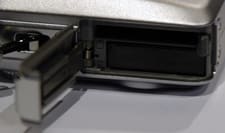
Battery
*When the camera is tired, it has a comfy dock to rest in. It can transfer photos while the battery is recharging. The V7 comes with a skinny lithium-ion NP-50 cell that can snap about 240 shots before needing another recharge, according to Casio’s specs.
Memory
There is a smidgeon of internal memory in the Casio EX-V7. 11.6 MB doesn’t go very far. At the top 7.2-megapixel resolution, it can only hold about three pictures. There are more Best Shot modes than that! SD, SDHC, and MMC memory cards can also be used.
Other features
Voice Memos – In the playback menu, users can opt to record stereo audio up to 30 seconds with each image.
Audio Snap – This feature can be turned on and off in the recording menu. When it is activated, the camera records up to seconds of audio when the shutter release button is pressed down (after snapping the picture).
Dynamic Range Setting – This feature isn’t seen on earlier Casio digital cameras. This new feature supposedly captures a bit more shadow and highlight detail, but not enough that we can see it on the LCD screen on the show floor. This is something we would look at more closely in a full review. The following options are available in recording and playback modes: Off, Expand +2, and Expand +1.
Portrait Refiner – Another new feature to Casio’s digital cameras, this may try to make up for the lack of a wider aperture. ND Filter +2, ND Filter +1, and Off can be chosen in the recording menu. I tried it, but really couldn’t tell a difference just on the LCD screen. Subtle differences may be seen in the final image though, which cannot be seen until this camera is fully reviewed.
Overall Impressions
Value
The $399 price tag on the Casio Exilim Hi-Zoom EX-V7 is quite steep. This 7.2-megapixel digital camera may be "the world’s thinnest 7x zoom digital camera," but it isn’t the only small camera with lots of zoom. Kodak’s dual lens cameras will be competitors, along with Panasonic’s TZ1 and Nikon’s S4; however, it does offer image stabilization, potentially more dynamic range, and a host of manual settings. The EX-V7 is on the pricier side though, so if its image quality isn't superior, consumers will likely be better served with its less expensive competition.
Who It’s For
Point-and-Shooters – These consumers will appreciate having a little extra zoom in a compact package that comes with an "easy" mode.
Budget Consumers – The price tag on the Casio V7 is $399, which seems a little steep for a 7.2-megapixel digital camera even if it is touted as the "world’s thinnest" to have 7x optical zoom (and image stabilization).
Gadget Freaks – While gadget freaks would love to introduce their latest acquisition as "the world’s thinnest 7x digital camera," there isn’t too much else to show off.
Manual Control Freaks – There are manual controls on the V7, but the truly freakish won’t like the way they are accessed with the Set button and multi-selector.
Pros / Serious Hobbyists – This digital camera isn’t even a breeze of a thought in the minds of professionals and serious hobbyists.
Conclusion
Conclusion
Crowned with the title of "the world’s thinnest" digital camera with a 7x optical zoom lens, the Casio Exilim Hi-Zoom EX-V7 sounds a little too cool for what it actually is. The lens stays within the camera body at all times, which makes it sturdy and portable. But the zoom lens doesn’t provide nice, sharp pictures. The soft lens is helped by the optical image stabilization system but hindered by the ineffective auto focus system. The V7 does have manual exposure modes and controls, which is more than what can be said of most of its competitors, but the selection isn’t that great. The shutter speed and aperture ranges are quite disappointing. Because this is only a first impression of the camera, this isn’t the final word. But it looks like Casio has created another gimmicky digital camera that doesn’t perform as well as its advertisements claim - unless its image quality can ultimately prove otherwise.
Meet the tester

Emily Raymond
Editor
Emily Raymond is a valued contributor to the Reviewed.com family of sites.
Checking our work.
Our team is here to help you buy the best stuff and love what you own. Our writers, editors, and experts obsess over the products we cover to make sure you're confident and satisfied. Have a different opinion about something we recommend? Email us and we'll compare notes.
Shoot us an email